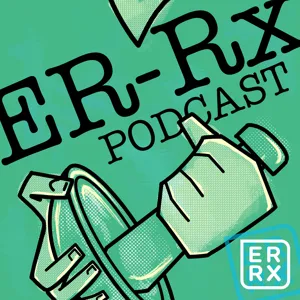Podcast Summary
Discussing Card Rewards and Medical Interventions: The Capital One Venture X Card provides 2X miles on every purchase and premium travel benefits, while Kroger guarantees customer satisfaction or their money back.
The Capital One Venture X Card offers cardholders unlimited 2X miles on every purchase, along with premium travel benefits like airport lounge access and a $300 annual credit for bookings. Meanwhile, shopping at Kroger with their brand products guarantees customers' satisfaction or their money back. During the podcast, the hosts discussed therapeutic hypothermia, a medical intervention where patients are exposed to lower temperatures to enhance medical treatments, which has been practiced since the Napoleonic Wars. The hosts also shared their amusing office experiences and encouraged listeners to check out related links on their podcast page for further reading.
Discovering the Healing Power of Cold Temperatures: During the late 1800s, exposing wounded soldiers to cold temperatures led to better recovery outcomes. This discovery was later studied by doctors and used in various medical conditions to reduce tissue injury and brain damage, but its use gained a negative reputation due to ethical concerns from WWII experiments.
Exposing wounded soldiers to cold temperatures instead of keeping them warm during the late 1800s led to better recovery outcomes. This discovery was later investigated by doctors like Dr. Temple Fay in the 1930s and Dr. Peter Safar in the 1950s and 60s, who used therapeutic hypothermia to reduce tissue injury and brain damage in various conditions, such as traumatic brain injuries, cardiac arrest, and even newborn infants with systemic encephalopathy. However, the use of hypothermia gained a negative reputation due to the Nazis' and Japanese military's inhumane experiments during World War II. Despite the ethical debates, the scientific community eventually recognized the potential benefits of hypothermia and began to explore its applications more seriously.
Discovering the life-saving benefits of hypothermia: NASA's discovery that gradual warming, not initial cold exposure, is the key to survival during extreme conditions has revolutionized medicine and space exploration.
The process of slowing down the body to protect it from extreme conditions, whether for space travel or reviving someone who has been underwater for an extended period, is based on the idea of hypothermia preserving life rather than ending it. NASA and researchers in the 1950s discovered that it's not the initial exposure to cold that kills, but rather the rapid warming up in the wrong circumstances. This counterintuitive finding has led to significant advancements in medicine and space exploration. One notable example is the case of a woman who fell into a frozen stream and was submerged for 80 minutes, during which her heart stopped and she was presumed dead. However, when she was reheated 10 days later, she fully recovered. This discovery has shown that the fine line between life and death lies in the cooling and warming processes, and researchers are still working to perfect this technique.
The Complexity of Therapeutic Hypothermia: Doctors use therapeutic hypothermia to increase survival chances after surgery by slowing down the body's metabolic rate, but the fine-tuning and nuances remain a challenge
Therapeutic hypothermia, which is the process of lowering body temperature for medical reasons, is a complex and challenging procedure despite its logical intuition. Doctors are currently using it to increase survival chances after surgery by slowing down the metabolic rate and reducing energy demand. The body maintains a normal core temperature between 96 and 98.6 degrees, and by lowering temperature, we can slow down the body's engine. This physics-based concept of life suggests that atoms arrange themselves to take in energy and dissipate heat efficiently, making it a natural part of being alive. However, the fine-tuning and nuances of therapeutic hypothermia remain mysterious and challenging, as brilliant doctors have acknowledged it as a "dog-gone-hard" process. Meanwhile, for parents looking for a safe social media platform for their kids during spring break, Zigazoo offers a solution with no commenting, text messaging, and 100% human-moderated community.
Medically induced hypothermia: Slowing down the body for medical interventions: Medically induced hypothermia uses cold temperatures to slow down body functions, saving lives during interventions like strokes and cardiac arrests, and extending operating time in surgeries.
Medically induced hypothermia is a technique used to slow down the body's functions, particularly the heart, by cooling the body. This can be done through the use of ice packs, cold blankets, or even chilled saline. The application of this technique can serve both intervention and preventative purposes. In intervention cases, it can help prevent further damage during incidents like strokes or cardiac arrests. Preventatively, it can extend operating time in surgeries where the heart needs to be stopped. By slowing down the body's functions, less oxygen is required, reducing the demand on the heart. This is particularly important for the brain, which needs a constant supply of oxygen to function properly. Medically induced hypothermia has been used to extend the time between when a person appears to be dead and when they are actually dead, allowing for better intervention in critical situations. It's a fascinating application of cold temperatures to extend the boundaries of medical procedures and save lives.
Preventing brain damage during heart attacks with hypothermia: Inducing medical hypothermia during a heart attack can help prevent brain damage by reducing neuron metabolism and preventing excessive glutamate release, increasing chances of survival without brain damage.
During a heart attack, the lack of oxygen can cause the brain to switch to anaerobic respiration and produce harmful substances, leading to brain damage and potential neurological issues. However, inducing medical hypothermia can help stop this process by reducing the metabolic rate of neurons and preventing the release of excessive glutamate. This gives the brain time to rebuild itself, potentially reducing the risk of brain damage. Only 10% of cardiac arrests outside of a hospital result in survival without brain damage due to the small window of time before irreversible damage occurs. By applying cold temperatures and bringing hypothermia on, doctors can stop the harmful process and give the brain the best chance to recover.
Social media for kids and medical treatment: Zigazoo: A kid-safe platform for content creation and interaction. Therapeutic hypothermia: A medical treatment to prevent brain damage during cardiac arrest, requiring close monitoring to prevent ice crystal formation. Airbnb: A platform for homeowners to rent out their spaces for extra income.
Zigazoo is a safe and fun social media platform for kids, allowing them to create content, interact with friends, and explore trends without the risks of commenting or text messaging. Meanwhile, therapeutic hypothermia, a medical treatment used during cardiac arrest, involves carefully cooling the patient to prevent brain damage, using methods such as sedation, ice packs, and paralytics to maintain a stable and still body. During this process, doctors must monitor the patient closely to prevent ice crystals from forming and causing further damage. On a different note, Airbnb provides an opportunity for homeowners to rent out their spare rooms or entire homes to generate extra income during events or vacations.
Managing electrolytes and controlled rewarming in forced air blankets: Researching hibernation techniques in animals could lead to advancements in preserving organs and reducing complications during rewarming.
Forced air blankets, used for preserving body temperature during extreme cold conditions, involve careful management of electrolytes and slow, controlled rewarming to avoid complications like arrhythmia and blood clots. Research into hibernation techniques in animals, specifically their ability to manipulate platelets and white blood cells, could lead to significant advancements in preserving organs and reducing post-warming complications. Hibernation itself, a state of reduced body temperature and inactivity, offers insights into potential methods for preserving life and extending the shelf life of organs.
Understanding Hibernation in Animals and Humans: Animals hibernate to conserve energy and avoid muscle atrophy. Humans, with 98% shared genes with hibernating primates, may possess a hidden hibernation ability. Remarkable human survival stories offer insights. NASA researches human hibernation for space missions.
Animals, particularly those that hibernate, have unique abilities to prepare for harsh conditions by conserving energy and avoiding muscle atrophy, even when food becomes scarce. Humans, on the other hand, do not naturally hibernate, but we share about 98% of our genes with hibernating primates, suggesting a potential hidden ability. Remarkable cases of humans surviving extreme cold for extended periods, such as Mitsutake Yuchikoshi's 24-day hibernation-like state, provide insights into the possibilities of manipulating human hibernation for medical or space exploration purposes. NASA is currently leading research in this area, focusing on suspended animation techniques to preserve human life during long space missions.
Unconventional methods for relaxation and preserving life during wartime: During wartime, soldiers used homemade gin for relaxation and doctors explored medically induced hypothermia to save lives. Researchers are now investigating severe hypothermia or suspended animation for emergency preservation and resuscitation, which could revolutionize trauma care.
During wartime, trauma hospitals face immense challenges due to the urgent need to save lives. Soldiers, including those in M*A*S*H units, have turned to unconventional methods for relaxation, such as homemade gin. The concept of medically induced hypothermia emerged, allowing doctors to buy time to treat severe injuries or allow the body to heal itself. Researchers like Sam Tischerman from the University of Pittsburgh are currently exploring the use of severe hypothermia or suspended animation for emergency preservation and resuscitation. This technique, which involves flushing the body with freezing cold saline solution, has shown promise in animal studies. However, it's crucial to note that resuscitation after blood loss due to trauma is different from cardiac arrest, and CPR is not effective. Instead, extreme cold temperatures are used to halt metabolic processes and preserve the body. This research could revolutionize trauma care and save countless lives.
Medically induced hypothermia increases survival rates but comes with risks: Cooling the body to extreme temperatures can save lives, but it's risky and requires consent, while satire can entertain and provoke change by highlighting absurdities
Medically induced hypothermia, or cooling the body to extremely low temperatures, has been shown to increase survival rates in certain situations, such as cardiac arrest. This was discovered through experiments with animals and human soldiers who survived prolonged exposure to extreme cold. However, there are risks involved, including pneumonia and blood clotting issues. Consent is also a challenge when applying this treatment to humans. Skepticism remains, but studies have shown significant recovery improvements with this method. Regarding satire, it's not just a form of entertainment that lets people release their anger towards leadership without demanding change, but it can also plant the seeds of dissent in a non-threatening way, potentially leading to real change. By highlighting the absurdity of certain situations or behaviors, satire can raise awareness and provoke thought. So while it may serve as a form of escape or catharsis, it can also play a role in shaping public opinion and driving change.
Exploring safer social media options for kids and top-notch credit card perks: Platforms like Zigazoo offer a safe social media experience for kids with verified members and human moderation. Discover provides excellent customer service and fraud liability protection with their credit cards.
There are platforms designed to provide a safe and positive social media experience for kids, such as Zigazoo, where all members are verified and content is fully human moderated. Another takeaway is that Discover aims to make everyone feel special by offering excellent customer service and fraud liability protection with their credit cards, ensuring that everyone feels valued regardless of their circumstances. For families looking for a safer social media experience for their kids during spring break or anyone seeking a credit card with top-notch customer service and fraud protection, these options could be worth exploring. Remember, you can engage with us further by tweeting @SYSKpodcast, joining us on Facebook.com/step, sending an email to StuffPodcast.howstuffworks.com, or visiting StuffYouShouldKnow.com for more information.






